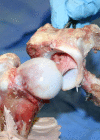Ligamentum teres maintenance and transfer as a stabilizer in open reduction for pediatric hip dislocation: surgical technique and early clinical results
- PMID: 19308575
- PMCID: PMC2656808
- DOI: 10.1007/s11832-008-0103-3
Ligamentum teres maintenance and transfer as a stabilizer in open reduction for pediatric hip dislocation: surgical technique and early clinical results
Abstract
Purpose: The ligamentum teres has primarily been considered as an obstruction to reduction in children with developmental dislocation of the hip (DDH). In the early surgical descriptions of both the medial (Ludloff) approach and the anterior (Salter) approach to the hip, it was generally accepted that the ligamentum teres was an obstruction to reduction and was excised (similar to the discarding of menisci for knee surgery in our orthopedic history). Because of the known propensity for early re-dislocation following open reduction, we developed surgical methods for maintaining the ligamentum teres when performing open reduction for hip dislocation in young children. This study presents the surgical methods developed for ligament maintenance and transfer, and analyzes the early clinical and radiographic results in a study group.
Methods: The techniques for open reduction by both the medial Ludloff approach and the anterior open reduction were developed and refined. Twenty-one children (23 hips) had ligamentum teres shortening and transfer performed as part of either a medial Ludloff or anterior open reduction for hip dislocation. Complete pre-operative and post-operative clinical and radiographic analysis was performed.
Results: All patients had stable hips at follow-up. The transferred ligamentum teres appeared to provide additional stability to prevent repeat dislocation. We noted no apparent loss of hip motion or other adverse events. One patient had avascular necrosis (AVN).
Conclusions: In this series of 23 hips, in which ligamentum teres transfer/tenodesis was utilized, we found no residual subluxation or dislocation in either the medial Ludloff or the anterior open reduction groups. Based on these early positive results, we recommend the method for children treated with the Ludloff open reduction procedure. Although we have less experience with it, the technique presented for ligamentum maintenance and transfer in anterior open reduction may provide similar added stability. This is an early follow-up study, and long-term follow-up will be required to confirm the ultimate femoral head and acetabular development.
Figures




Similar articles
-
Ligamentum Teres Transfer During Medial Open Reduction in Patients with Developmental Dysplasia of the Hip.Iowa Orthop J. 2021;41(1):47-53. Iowa Orthop J. 2021. PMID: 34552403 Free PMC article.
-
Ligamentum teres tenodesis in medial approach open reduction for developmental dislocation of the hip.J Pediatr Orthop. 2008 Sep;28(6):607-13. doi: 10.1097/BPO.0b013e318184202c. J Pediatr Orthop. 2008. PMID: 18724195
-
Video Technique on Medial Open Reduction for DDH.Indian J Orthop. 2021 Dec 20;55(6):1605. doi: 10.1007/s43465-021-00502-6. eCollection 2021 Dec. Indian J Orthop. 2021. PMID: 35003549 Free PMC article.
-
[Open reduction technique].Orthopade. 1997 Jan;26(1):67-74. doi: 10.1007/s001320050071. Orthopade. 1997. PMID: 9082305 Review. German.
-
Anatomy, biomechanics, imaging, and management of ligamentum teres injuries.Radiographics. 2010 Oct;30(6):1637-51. doi: 10.1148/rg.306105516. Radiographics. 2010. PMID: 21071380 Review.
Cited by
-
The position and morphometry of the fovea capitis femoris in computed tomography of the hip.Surg Radiol Anat. 2019 Jan;41(1):101-107. doi: 10.1007/s00276-018-2097-y. Epub 2018 Aug 31. Surg Radiol Anat. 2019. PMID: 30171297 Free PMC article.
-
Histological Structure and Immunohistochemical Properties of the Ligamentum Teres in Patients With Developmental Dysplasia of the Hip.Cureus. 2024 May 6;16(5):e59748. doi: 10.7759/cureus.59748. eCollection 2024 May. Cureus. 2024. PMID: 38841047 Free PMC article.
-
The reliability of commonly used arthroscopic classifications of ligamentum teres pathology.J Hip Preserv Surg. 2017 Mar 5;4(2):187-193. doi: 10.1093/jhps/hnx005. eCollection 2017 Jul. J Hip Preserv Surg. 2017. PMID: 28630741 Free PMC article.
-
THE ROUND LIGAMENT IN DEVELOPMENTAL HIP DYSPLASIA: ARE ITS MECHANICAL AND HISTOLOGICAL PROPERTIES PRESERVED?Acta Ortop Bras. 2022 Jan 28;30(1):e235808. doi: 10.1590/1413-785220223001e235808. eCollection 2022. Acta Ortop Bras. 2022. PMID: 35431634 Free PMC article.
-
Developmental dysplasia of the hip: What has changed in the last 20 years?World J Orthop. 2015 Dec 18;6(11):886-901. doi: 10.5312/wjo.v6.i11.886. eCollection 2015 Dec 18. World J Orthop. 2015. PMID: 26716085 Free PMC article. Review.
References
-
- Trueta J, Harrison MHM. The normal vascular anatomy of the femoral head in adult man. J Bone Joint Surg Br. 1953;35:442–461. - PubMed
-
- Ippolito E, Ishi Y, Ponseti IV. Histologic, histochemical, and ultrastructural studies of the hip joint capsule and ligamentum teres in congenital dislocation of the hip. Clin Orthop Relat Res. 1980;146:246–258. - PubMed
-
- Calandriello B, Mignani G. The role of the ligamentum teres in congenital dislocation of the hip. Clin Orthop Relat Res. 1962;22:60–72.
-
- Michaels G, Matles AL. The role of the ligamentum teres in congenital dislocation of the hip. Clin Orthop Relat Res. 1970;71:199–201. - PubMed
LinkOut - more resources
Full Text Sources
Other Literature Sources
Research Materials

